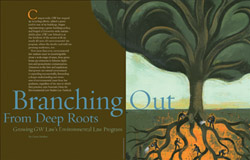Branching Out From Deep Roots
Growing GW Law’s Environmental Law Program
Campus wide, GW has stepped up recycling efforts, added a green roof to one of its buildings, begun implementing a green buildings policy, and forged a University-wide sustainability plan. GW Law School is at the forefront of the action with its nearly 40-year-old environmental law program, where the faculty and staff are greening academics, too.
Now more than ever, environmental law students must be knowledgeable about a wide range of issues, from greenhouse gas emissions to fisheries depletion and groundwater contamination. Attention to the laws and regulations that govern our natural environment is expanding exponentially, demanding a deeper understanding and awareness of environmental issues from law graduates, regardless of the area in which they practice, says Associate Dean for Environmental Law Studies Lee Paddock.
“In my ideal world, corporate lawyers would have had some environmental law experience—they might have taken a climate course or a course on air pollution,” Paddock says. “Today, at least a portion of their practice is inherently an environmental practice.”
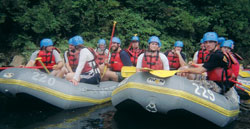
GW Environmental Law Association students and GW Law professors enjoy the great outdoors that they work to protect on an annual rafting trip to the Youghiogheny River in Garrett County, Md.
Courtesy of GW Environmental Law Association
The Law School’s environmental law program is among the largest and longest standing in the country and will celebrate its 40th anniversary this year. At the same time, it’s branching out into new areas such as climate, energy, and emerging technologies like genomics and nanotechnology.
Budding lawyers can choose from classes such as Toxic Tort Litigation, International Environmental Law, Environmental Crimes, Air Pollution Control, and a dozen more, plus get professional experiences through clinics, internships, and outplacements, all of which helps students prepare for challenges ahead.
Associate Professor of Law Jamie Grodsky, who teaches such courses as environmental law survey and torts as well as a class on science, technology, and the Constitution, adds that “environmental law provides a terrific foundation, as the field incorporates so many areas of the law. As an environmental lawyer, one can—and must—be a Renaissance lawyer.”
Adapting to Today’s Green Challenges
Many forms of pollution, including greenhouse gases, cross national or international boundaries. Now more than ever, law students must be prepared to work in a world where environmental laws from the European Union and many other countries matter in their daily practice, as eco-problems continue to snowball.
“Environmental law as a field is still new and changing, especially with climate change, and it has fairly young laws, so there’s still adjustment happening,” says Caitlin Meisenbach, a 2L who has planned to practice environmental law since high school and hopes to practice at a government agency such as the Environmental Protection Agency, where she’s been working for the past year. Meisenbach also has been involved with the Environmental Law Association on campus, which in the past year has organized a panel on presidential candidates’ positions on environmental issues, planned outdoor activities such as whitewater rafting, and organized Footprint Week, targeted at raising awareness about carbon footprints.
“It’s a vast field that I don’t think would be easy to jump into if you didn’t have the background,” Meisenbach says. “There’s a wide body of law with lots of acronyms that can look like alphabet soup” unless you have environmental experience, she explains.
Gaining that edge is invaluable as graduates compete for a limited number of available jobs, says GW Law School alumna Rebekah Reynolds, JD ’07, who is now an enforcement attorney for the U.S. EPA in Dallas, where she works with noncompliance cases. “Specialized training shows that the student is committed to environmental law and helps students secure better internships/clerkships/first jobs as an attorney.”
“Environmental law graduates face a different world than that faced by those who earned law degrees a generation earlier,” wrote Paddock in the fall 2008 Environmental Perspectives newsletter. In the 1980s, graduates had to deal with environmental problems created by big industrial facilities. Today, environmental law students must address problems like climate change, polluted water caused by farmers and developers, urban air pollution, and inefficient use of energy that require us to change if the problems are to be solved. In addition, we are now dealing with the first wave of new nanotechnologies that will present difficult environmental challenges. All of these issues require a much broader set of legal skills, Paddock says.
Teaching a lawyer the Clean Air Act or Clean Water Act, the cornerstones of air and surface water quality protection, and how you enforce these laws is critical but not enough, Paddock says. “They have to learn about international law, about negotiating skills, about energy regulation, and they have to have a broader understanding of what drives individual behavior.”
Today’s more complex problems are caused not only by large facilities but by smaller organizations and individual conduct. Take cleaning up the Chesapeake Bay, for instance: In addition to wastewater treatment plants, drivers, homeowners’ lawns, farmers, developers, and construction crews all contribute to the problem. “So you’re dealing with thousands of facilities, not a few hundred large polluters,” Paddock explains.
“Environmental lawyers also must understand civil rights law as environmental justice considerations continue to be integrated into environmental decisions,” says Grodsky, who has held legal positions in all three branches of government.
The field is becoming more complex, but there has also never been a more exciting time for environmental law, as environment and energy climb to the top tier of the public agenda again, and the problems are big and serious. “To be helping law students step in and be part of the solution at this time in history is an exciting thing to be doing,” Paddock says. “This is a unique time to be working in environmental law.”
Breathing New Life into an Old Act
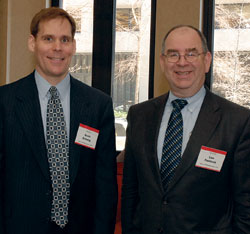
Scott Schang, editor-in-chief of the Environmental Law Reporter, and Associate Dean of Environmental Law Studies Lee Paddock during the March NEPA Law Conference, titled “NEPA at 40: How a Visionary Statute Confronts 21st Century Environmental Impacts”
Claire Duggan
Part of the mission of the GW Law program is to identify changes in public policy that will help solve the country’s complex environmental problems. A recent conference recognizing the 40th anniversary of landmark legislation, the National Environmental Policy Act (NEPA), is a good example of this involvement in real world problem solving.
The prescient NEPA legislation recognized in 1969 the effects of human activities on natural environments and takes into account the influences of population growth, high density urbanization, industrial expansion, resource exploitation, and new technological advances.
Because of its importance in bringing environmental issues to the minds of politicians, planners, and developers, the 40th anniversary of the act was the focus of this year’s J.B. and Maurice Shapiro Environmental Law Conference in March. Law students, practicing attorneys, legal scholars, and top governmental decision makers reviewed how the act started, what it has accomplished, and its application to today’s environmental challenges.
“Forty years ago, in 1969, on the heels of the Santa Barbara oil spill, Congress passed the National Environmental Policy Act and signed it into law on New Year’s Day, 1970, launching the environmental decade of the 1970s,” Grodsky told students, faculty, and lawyers at the opening of the conference.
“NEPA itself marked a dramatic turning point for thinking about how actions affect the environment,” said conference keynote speaker Nancy Sutley, the newly appointed chair of the Council on Environmental Quality. “NEPA called for a holistic environmental approach that included social and economic values.”
The act has fundamentally changed the way the U.S. government does business, Grodsky explained. The act has remained virtually unchanged since enacted. Brief, simple, broadly applicable, and durable, Grodsky continued, the act inspired more than 75 nations to adopt similar measures, and over half of the states in the United States have put their own versions into law.
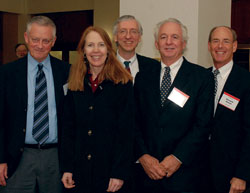
(From left) William Rodgers, University of Washington Law School; GW Law professor Jamie Grodsky; James McElfish, senior attorney, Environmental Law Institute; Ray Clark, senior partner, the Clark Group; and Ken Weiner, partner, K&L Gates
Claire Duggan
“We can do cost-benefit analysis and have engineering and science that says this is the best way to do something, but we also need to think about what’s the impact on real people in their communities, the things that we hold dear and cherish,” Sutley said. “These things are harder to quantify, but nevertheless are important.”
“NEPA does give us the opportunity to think about trade-offs and alternatives,” Sutley added. She also said that the National Environmental Policy Act’s strength is to inform decision makers, policymakers, and the public of the environmental cost of making choices.
Understanding the options that may reduce the environmental impact of government decisions is crucial as environmental problems grow in scale and affect basic services such as energy production and use.
“The NEPA conference is one of the many ways students get to see that synergy between legal academia and public policy,” says Grodsky, who won national awards for her recent articles, “Genetics and Environmental Law: Redefining Public Health,” published in the California Law Review, and “Genomics and Toxic Torts: Dismantling the Risk-Injury Divide,” in the Stanford Law Review.
GW Law is looking for ways to follow up with the Council on Environmental Quality “because a lot of good ideas emerged from that program,” Paddock says, including finding better ways to deal with environmental impact analysis in the context of stimulus spending.
New Shoots and Roots
GW Law’s environmental law program will branch out farther with its new Journal of Energy and Environmental Law, which will be published jointly with the Environmental Law Institute. The student-edited journal will help attract top law students, provide an avenue for law students to publish papers and theses, and influence public policy. “Publishing is also a credential that’s important for employers,” Paddock notes.
The twice-yearly law journal will immediately gain credibility from its association with the Environmental Law Institute, as well as a built-in circulation of 700 subscribers to The Environmental Law Reporter News and Analysis.
GW also has the advantage of location and connection to decision makers, which would boost the journal’s readership. All 18 of the top 20 environmental law programs publish environmental law journals, says Paddock, who will serve as journal adviser.
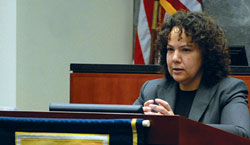
Nancy Sutley, the newly appointed chair of the Council on Environmental Quality, was the keynote at this year’s J.B. and Maurice Shapiro Environmental Law Conference in March. She said that the National Environmental Policy Act’s strength is to inform decision makers, policymakers, and the public of the environmental cost of making choices.
Claire Duggan
In the classroom, too, professors are adding environmental classes. In addition to the new International Climate Change Law course (see sidebar), the Law School has authorized a new Energy and Environmental Law track for its environmental law master’s degree program. The environmental outplacement program is also expanding. Paddock teaches an Environmental Lawyering co-requisite course so students “can deal with issues they are likely to confront in the practice of environmental law, such as ethical questions, problem-solving exercises, drafting memoranda, and presentation skills in the specific context of environmental law work,” he explains.
Students are also engaged in pro bono projects that may lead to expanded clinical education opportunities.
“We plan to have a unique public policy focus for the environmental law clinic, taking full advantage of GW’s location at the center of national policymaking,” Grodsky says. “Students will gain experience in commenting on rules and drafting bills.”
One student has been working with the nonprofit organization Bread for the World on emergency food relief issues; another is working with the Potomac and Anacostia Riverkeepers on water pollution problems.
“They’ve been doing this work on a volunteer basis, but next fall, we may take up one or both of those projects in a clinical context,” Paddock explains, “allowing the students to earn academic credit rather than just volunteer time.”
This summer, Robert Glicksman will be joining the environmental law faculty as the J.B. and Maurice C. Shapiro Chair of Environmental Law. Glicksman, formerly of the University of Kansas School of Law, brings expertise that spans pollution control and public natural resources law. His recent research has focused on federalism and administrative law questions, including those relating to climate change.
Ready for the Real World
The best measure of any environmental law program is how well it prepares future lawyers for the real world.
A strong outplacement clinical program helps GW Law students gain invaluable experiences and contacts. Law students currently work at a wide range of government offices such as EPA’s Office of Enforcement, the D.C. Department of the Environment and the Council of Environmental Quality, as well as nonprofits such as Oceana, the Natural Resources Defense Council, and the Washington Area Council of Governments. The list is growing. These opportunities test student’s skills and allow them to learn how environmental issues play out in real agencies and organizations.
“There are many GW alumni working in the area of environmental law, and that is an instant network of people to connect with,” says alumna Reynolds. “I probably got my internship with the U.S. Department of Justice’s Environment and Natural Resources Division’s Natural Resource Section because one of the attorneys in that office was a GW graduate, and they had hired and had good luck with interns from GW Law in the past.” In law school, Reynolds was president of the Environmental Law Association and during her third year helped organize a national environmental law conference that featured former Vice President and environmental champion Al Gore.
Katie Lannon, who is interning at the EPA and worked at a law firm last summer where she specialized in environmental law, agrees that an environmental law network is vital. “A big part of the program is the community of students,” she says. Lannon is former president of the GW Environmental Law Association and finds a valuable resource in other students’ advice on classes, internships, and contacts.
Being able to experience the leading edge of environmental law through practical experience is especially important in a field that’s constantly changing. Many environmental lawyers specialize within the environmental field “because it’s hard to be an expert in everything,” says Lannon, who herself hasn’t settled on a specialization in order to keep options open. GW Law School’s environmental law students are choosing from climate change law, international fisheries law, land use law, and more to focus on for future careers.
“We want students to be able to understand what the issues are and be able to advise clients in a way that allows clients to deal with the issues,” Paddock says. “The environment needs to be imbedded in decision making and not something that’s separate and after the fact.”
New Law Course Focuses on Climate Change Challenges

David Freestone, international climate change law expert and a visiting professor, taught GW Law’s new climate change course during spring semester.
The dramatic images of acre-wide icebergs cleaving off of Antarctica and rising sea waters claiming small Pacific islands remind us that our warming planet is in peril. To prepare future lawyers and legal advisers to handle this worldwide problem, GW Law’s environmental law program is counting global warming as a serious academic subject. The Law School’s new class, International Climate Change Law, started in spring and is possibly the first law course in the nation devoted to such challenges.
The class, which had 40 students in its first semester, explores carbon trading, adaptation, sea level rise, the legal regimes created by the United Nations Framework Convention on Climate Change and the Kyoto Protocol, plus legal challenges of forest carbon sequestration and state and voluntary carbon credit schemes.
Associate Dean for Environmental Studies Lee Paddock says the course fulfills a growing need. “Climate is probably the top environmental issue now,” Paddock says. “Law firms across the country in the last two years have been adding climate practice groups to their organizations.”
While the Law School’s two energy classes and its international environmental law courses have often included discussions on climate, faculty members wanted to devote an entire class to the topic. So they brought on board David Freestone, international climate change law expert, to teach GW Law’s lawyers-in-training about climate laws and related issues.
“[Freestone] is an expert on international climate negotiations and emissions trading, so it made sense to have him start a new class focused on international climate change law,” Paddock says. Freestone, who joined the faculty in January, is the Lobingier Visiting Professor of Comparative Law and Jurisprudence Chair at GW Law School, an 18-month position.
The course is so cutting-edge that there’s not even a textbook yet, Freestone notes, and he relies on his own published articles and books for some of the reading material. Carbon trading is a major topic of the course, and it’s among Freestone’s areas of expertise.
“A lot of the course is about the mechanisms under the Kyoto Protocol which allow developed country parties and their companies to invest in projects in economies in transition and in developing countries that reduce carbon emissions; this is the rapidly developing legal field of carbon finance,” Freestone says. Carbon trading is now a more than $100 billion dollar-a-year business. To provide experience for his pupils, the professor arranged for a mock carbon negotiations session led by two lawyers from the carbon finance group at the World Bank.
Climate change is also a justice issue, explains Freestone, who has investigated sea level rise impacts in Bangladesh. “Some 200 million people could be displaced in the Brahmaputra Delta,” he says. “We in the industrialized countries caused it, yet it’s the poorest countries that are going to be impacted the most.”
To add voice and variety to the class, Freestone brought in guest lecturers to talk about forest carbon, the adaptation capacity of coastal ecosystems, the World Trade Organization, and the European Union Emissions Trading System.
Freestone is uniquely qualified to lead the course and establish its focus because the subject is his passion. Most recently, he served as senior adviser and as deputy general counsel at the World Bank, where he also worked for eight years as chief counsel and head of the environment and international law group and helped start the first-ever Carbon Fund in 2000. In 1991, he edited and contributed to one of the first books on the legal aspects of climate change. He has also recently finished another book called Legal Aspects of Carbon Trading, due to be published by Oxford later in the year in time for the crucial Copenhagen Meeting.
Freestone, who also serves as senior adviser to the U.S. Multilateral Office of the International Union for the Conservation of Nature and Natural Resources, will teach an international marine environmental law seminar in the fall. But he says that GW Law’s climate change law course will help prepare future lawyers for today’s complex issue of climate change.
“It’s the defining environmental issue of the century,” he says. “It’s affecting ecosystems, civilizations, and it will be a major challenge for the international community to address these huge issues.”
—Carrie Madren

